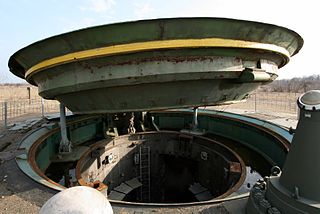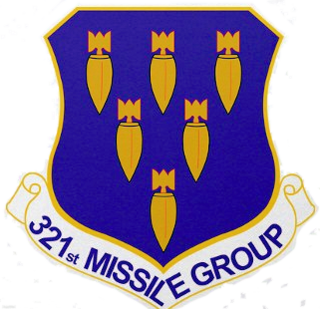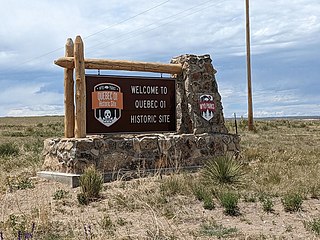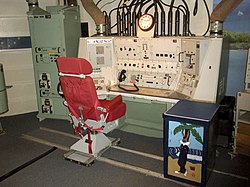
The LGM-30 Minuteman is an American land-based intercontinental ballistic missile (ICBM) in service with the Air Force Global Strike Command. As of 2024, the LGM-30G is the only land-based ICBM in service in the United States and represents the land leg of the U.S. nuclear triad, along with the Trident II submarine-launched ballistic missile (SLBM) and nuclear weapons carried by long-range strategic bombers.

Malmstrom Air Force Base is a United States Air Force base in Cascade County, Montana, United States, adjacent to the city of Great Falls. It was named in honor of World War II POW Colonel Einar Axel Malmstrom. It is the home of the 341st Missile Wing of the Air Force Global Strike Command (AFGSC). For statistical purposes, the United States Census Bureau has defined Malmstrom Air Force Base as a census-designated place (CDP). It had a population of 3,472 at the 2010 census.

Grand Forks Air Force Base (AFB) (IATA: RDR, ICAO: KRDR, FAA LID: RDR) is a United States Air Force installation in northeastern North Dakota, located north of Emerado and 16 miles (26 km) west of Grand Forks.

The Minuteman Missile National Historic Site is an American national historic site established in 1999 near Wall, South Dakota, to illustrate the history and significance of the Cold War, the nuclear arms race, and intercontinental ballistic missile (ICBM) development. The site preserves the last intact Minuteman II ICBM system in the United States, in a disarmed and demilitarized status. Guided tours are available of the underground Launch Control Center, and a missile silo can be observed from above. Some 450 of the newer Minuteman III missiles are still on active duty at Malmstrom AFB, Montana, Minot AFB, North Dakota, and F. E. Warren AFB, Wyoming.

Space Launch Complex 3 (SLC-3) is a launch site at Vandenberg Space Force Base that consists of two separate launch pads. SLC-3E (East) was used by the Atlas V launch vehicle before it was decommissioned in August 2021 with the final launch taking place on November 10, 2022 at 09:49, while SLC-3W (West) has been demolished.

A launch control center (LCC), in the United States, is the main control facility for intercontinental ballistic missiles (ICBMs). A launch control center monitors and controls missile launch facilities. From a launch control center, the missile combat crew can monitor the complex, launch the missile, or relax in the living quarters. The LCC is designed to provide maximum protection for the missile combat crew and equipment vital to missile launch. Missile silos are common across the midwestern United States, and over 450 missiles remain in US Air Force (USAF) service.

Atomic tourism or nuclear tourism is a form of tourism in which visitors witness nuclear tests or learn about the Atomic Age by traveling to significant sites in atomic history such as nuclear test reactors, museums with nuclear weapon artifacts, delivery vehicles, sites where atomic weapons were detonated, and nuclear power plants.

The 321st Air Expeditionary Wing was a United States Air Force unit assigned United States Air Forces Central, the USAF component command of United States Central Command. The unit was reestablished on 1 November 2008 and was a nexus of all Coalition Air Force Training Teams and the Iraqi Air Force at COB Speicher. It was previously the 321st Bombardment Group (Medium), which flew B-25 Mitchells in combat with the Northwest African Strategic Air Force in 1943 and the Mediterranean Allied Tactical Air Force in 1944–45.

Space Launch Complex 10, or Missile Launch Complex 10, is located on Vandenberg Space Force Base in Lompoc, California. It was built in 1958 to test ballistic missiles and developed into a space launching facility in 1963. Prior to 1966 Space Launch Complex 10 West was known as Vandenberg AFB Pad 75-2-6. It remains a rare pristine look at the electronics and facilities created in that era that helped the United States grow its space capabilities.

The 448th Missile Squadron is an inactive United States Air Force unit. It was last assigned to the 321st Missile Group at Grand Forks Air Force Base, North Dakota, where it was equipped with the LGM-30G Minuteman III Intercontinental ballistic missile (ICBM), with a mission of nuclear deterrence.

The Emergency Rocket Communications System (ERCS) was designed to provide a reliable and survivable emergency communications method for the United States National Command Authority, using a UHF repeater placed atop a Blue Scout rocket or Minuteman II intercontinental ballistic missile. ERCS was deactivated as a communication means when President George H.W. Bush issued a message to stand down SIOP-committed bombers and Minuteman IIs on 27 September 1991. Headquarters SAC was given approval by the Joint Chiefs of Staff to deactivate the 494L payloads beginning 1 October 1992. However, Headquarters SAC believed it was inefficient and unnecessary to support ERCS past fiscal year 1991, and kept the accelerated deactivation schedule.

A missile launch facility, also known as an underground missile silo, launch facility (LF), or nuclear silo, is a vertical cylindrical structure constructed underground, for the storage and launching of intercontinental ballistic missiles (ICBMs), intermediate-range ballistic missiles (IRBMs), medium-range ballistic missiles (MRBMs). Similar facilities can be used for anti-ballistic missiles (ABMs).

This is a list of the LGM-30 Minuteman missile Missile Alert Facilities and Launch Facilities of the 91st Missile Wing, 20th Air Force, assigned to Minot AFB, North Dakota.

This is a list of the LGM-30 Minuteman missile Missile Alert Facilities and Launch Facilities of the 321st Missile Wing, 20th Air Force, assigned to Grand Forks AFB, North Dakota.

The Ronald Reagan Minuteman Missile State Historic Site consists of two former missile sites around Cooperstown, North Dakota that were part of North Dakota military activities during the Cold War years: the Oscar-Zero Missile Alert Facility and the November-33 Launch Facility. The site is operated by the State Historical Society of North Dakota.
Air Force Plant Peter J. Kiewit and Sons is a Formerly Used Defense Site (CO7570090038) at the Colorado Front Range and used during the Cold War (1957-1968) to provide "rocket assembly, engine testing, and research and development") for the Titan missile complexes southeast of Denver. The 464 acres (188 ha) of former "Martin Missile Test Site 1" was "deeded" to the USAF in 1957, was subsequently operated by the builder, was listed on the EPA's National Priorities List on November 21, 1989; and remained USAF property until transferred to Lockheed Martin in February 2001. The site is used by, and entirely within, the secure Lockheed Martin/United Launch Alliance Waterton Canyon facility of 5,200 acres (2,100 ha) that produces Titan IV launch vehicles and the GPS III space vehicles. Entirely within the East Fork Brush Creek watershed, the former USAF firearms ranges used by PJKS military police remains along the creek, is managed by the Skyline Hunting and Fishing Club, and is used for periodic Jefferson County police and local Boy Scout training.

The Stanley R. Mickelsen Safeguard Complex (SRMSC) was a cluster of military facilities near Langdon, North Dakota, that supported the United States Army's Safeguard anti-ballistic missile program. The complex provided launch and control for 30 LIM-49 Spartan anti-ballistic missiles, and 70 shorter-range Sprint anti-ballistic missiles.

Whiteman Air Force Base is a United States Air Force base located just south of Knob Noster, Missouri, United States. The base is the current home of the B-2 Spirit bomber. It is named for 2nd Lt George Whiteman, who was killed during the attack on Pearl Harbor.
The Griggs County Museum contains thousands of pioneer artifacts going back to the 1880s and the days of Bonanza Farmers R.C. and T.J. Cooper after whom Cooperstown was named. The museum also contains the Northern Plains Cold War Interpretive Center which supplements a visit to the Ronald Reagan Minuteman Missile State Historic Site more commonly known as Oscar Zero.

The Quebec-One Missile Alert Facility, also known as Quebec-01 or Q-01, located 30 miles north of Cheyenne, Wyoming, near Chugwater, was a United States Air Force ICBM launch control facility. It was operated by the 400th Missile Squadron constructed in 1962. The Missile Alert Facility operated with a Minuteman missile until 1970 when it was converted to a Minuteman-III site. Finally in 1986, the facility was converted to operate the Peacekeeper ICBM. The facility was deactivated in 2005 and turned over to Wyoming State Parks in December 2017. The facility was opened to the public in August 2019 as the Quebec 01 Missile Alert Facility State Historic Site after restoration work done by the United States Air Force.


















